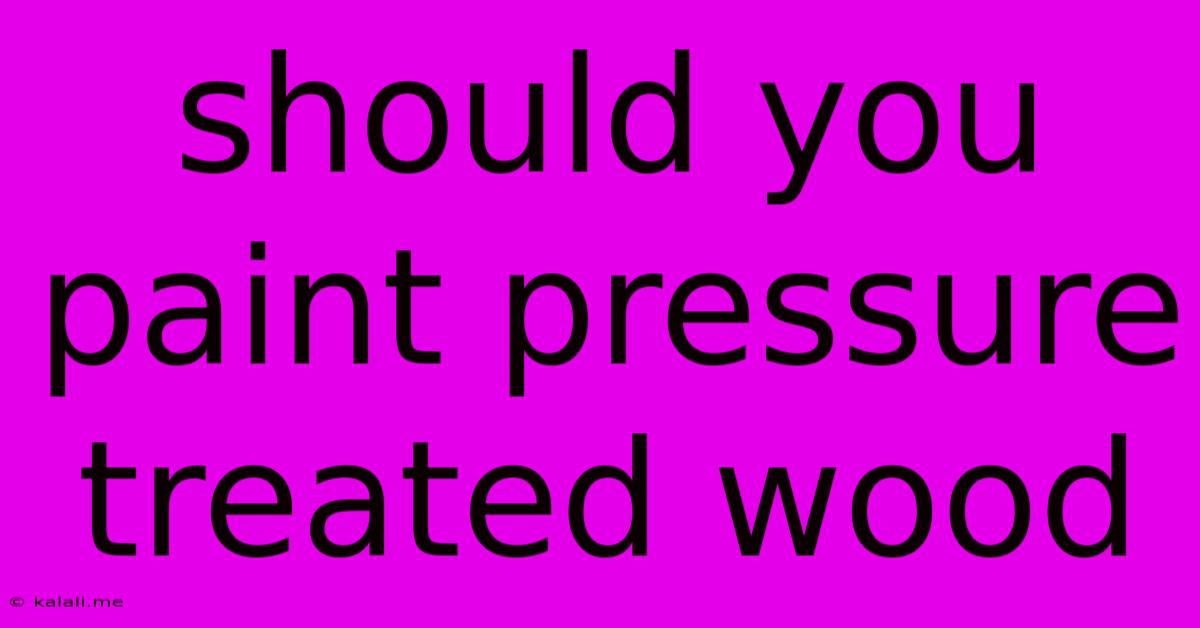Should You Paint Pressure Treated Wood
Kalali
May 20, 2025 · 3 min read

Table of Contents
Should You Paint Pressure Treated Wood? A Comprehensive Guide
Meta Description: Deciding whether to paint pressure-treated wood is a common dilemma. This guide explores the pros and cons, longevity considerations, and best practices for painting or staining your pressure treated lumber, helping you make the informed decision for your project.
Painting pressure-treated wood is a frequent question among DIYers and seasoned professionals alike. The answer isn't a simple yes or no; it depends on a variety of factors, including the type of wood, the intended use, and your personal preferences. This comprehensive guide will explore the pros and cons, helping you make the right choice for your project.
Understanding Pressure Treated Wood
Pressure-treated lumber is wood that has been infused with preservatives, typically chemicals like chromated copper arsenate (CCA) or newer, less-toxic alternatives. This process protects the wood from rot, decay, insect infestation, and fungal growth, making it ideal for outdoor projects like decks, fences, and retaining walls. However, these preservatives can sometimes interfere with paint adhesion and longevity.
The Pros of Painting Pressure Treated Wood
- Enhanced Aesthetics: Paint dramatically improves the visual appeal of pressure treated wood, allowing you to customize the color and finish to match your home's style. You can achieve a sleek, modern look or a more rustic feel, depending on your paint choice. Consider using exterior-grade paints specifically formulated for wood.
- Increased Protection: While pressure treatment offers inherent protection, paint provides an additional layer of defense against the elements, extending the lifespan of your wood structure. This is particularly beneficial in harsh climates with significant sun exposure, rain, or snow. Choose a paint with UV protection to prevent fading and deterioration.
- Improved Durability: Paint acts as a barrier, protecting the wood from moisture penetration, which is a major cause of rot and decay. This increased durability minimizes the need for frequent repairs or replacements. Proper surface preparation is key to achieving this enhanced durability.
The Cons of Painting Pressure Treated Wood
- Potential for Peeling and Blistering: If the wood isn't properly prepared, the paint may peel, blister, or chip prematurely. This is because the preservatives in the wood can react with certain paint types, preventing proper adhesion. Always allow sufficient drying time before painting.
- Limited Breathability: Paint creates a barrier that prevents the wood from “breathing,” potentially trapping moisture underneath the surface. This can lead to rot if not managed correctly. Ensure proper ventilation and consider using breathable paints or stains.
- More Frequent Repainting: While paint offers protection, it will eventually need repainting. The frequency depends on the quality of the paint, the climate, and the level of sun exposure. Exterior-grade paints are designed for longer lasting results.
Should You Paint or Stain?
Instead of paint, consider using a wood stain. Stains penetrate the wood, allowing it to breathe while still providing protection and color. Stains typically require less frequent reapplication than paint and are less likely to peel or blister. However, stains offer less protection against the elements than paint.
Best Practices for Painting Pressure Treated Wood
- Proper Preparation is Key: Thoroughly clean the wood to remove dirt, debris, and any existing mildew or mold. Allow the wood to dry completely before applying any primer or paint.
- Use a Suitable Primer: A high-quality primer designed for pressure-treated wood is crucial for proper adhesion. Primers help seal the wood and prevent the preservatives from interfering with the paint.
- Choose the Right Paint: Opt for an exterior-grade paint specifically formulated for wood and designed to withstand the elements. Look for paints with good UV protection.
- Apply Multiple Coats: Apply thin coats of paint, allowing each coat to dry completely before applying the next. This ensures better coverage and durability.
Conclusion: The Informed Choice
Whether or not to paint pressure-treated wood is ultimately a personal decision based on your priorities and project requirements. Carefully weigh the pros and cons, consider using a stain as an alternative, and always follow best practices for preparation and application to ensure a long-lasting, beautiful finish. Remember, proper preparation is the key to successful painting and maximizing the lifespan of your pressure-treated wood project.
Latest Posts
Latest Posts
-
3 Prong To Two Prong Adapter
May 21, 2025
-
Wiring A Ceiling Light With 4 Wires
May 21, 2025
-
What Does Kip Mean On Snapchat
May 21, 2025
-
Chirping Smoke Detector After Replacing Battery
May 21, 2025
-
How Did Gibbs Get The Boat Out Of His Basement
May 21, 2025
Related Post
Thank you for visiting our website which covers about Should You Paint Pressure Treated Wood . We hope the information provided has been useful to you. Feel free to contact us if you have any questions or need further assistance. See you next time and don't miss to bookmark.